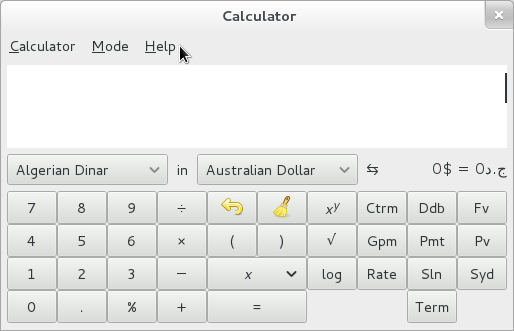Calculator
Contents
Introduction
A nice, simple GNOME 3 style calculator.
Designers
William Jon McCann
Objectives
- Calculate values to copy to the clipboard
- Calculate values to use outside the system (tips etc)
Constraints
Relevant Art
iPhone
WebOS

Rechner Calculator



Soulver


See http://www.acqualia.com/soulver/
Ubuntu Touch Calculator

GNOME 2





SpeedCrunch
Apps(2f)Calculator/speedcruch.png)
Apps(2f)Calculator/speedcruch2.png)
Apps(2f)Calculator/speedcruch3.png)
Qalculate
Apps(2f)Calculator/qalculate.png)
hbons calculator
Apps(2f)Calculator/hbons-calculator.png)
Discussion
I think there are two primary ways of interacting with a calculator.
- App mode
- A full immersion application (maximized) where the calculation is the task at hand. Perhaps for use outside the system.
- Service mode
- A peripheral / supplementary task where a calculation is needed in context in another app
I think the Calculator app is a good fit for the first and a somewhat poor (though capable) fit for the second. The second case is, perhaps, better handled by the on screen keyboard having a special calculation mode that can be automatically or easily invoked.
Tentative Design
Apps(2f)Calculator/Calculator.png)
High Resolution Concepts
This is work in progress and needs discussion with the Calculator maintainer.

Comments
For the service mode, this extension shows one way of integrating the service. People have been known to type calculations into Google (and I know I regularly use Google to do currency conversions). See the Calculator extension (-- BastienNocera 2012-03-30 10:11:49)
One of the challenges of designing a modern calculator is to break out of the traditional "make a physical calculator on my screen" and make a tool that does useful calculations for the user. There's also a challenge to get the right balance between a tool that is good at mathematics (e.g. matlab) and a tool that is highly accessible to all users. GCalctool has been over time trying to push the envelope here (been stalled for some time though due to lack of developer effort). Features that I think a design should aim for are:
- Supporting equations up to the complexity of polynomials
- Showing full equations in the display
- Using correct notation where possible (e.g. superscript for powers not ^ characters)
- Being correct in base 10 (some calculators use base 2 internally and show .999999999 type answers to some calculations which is confusing)
- Providing a method of converting units (e.g. the answer from meters to feet or UDS to EUR)
- Solving common calculations (e.g. mortgage terms, quadratic equations)
- A simple graphing feature
- Being able to store results (using a history and variables, M+, MR are horrible hangovers from old physical calculators)
(-- RobertAncell)
Note that GCalctool has an internal division between the GCalctool UI and the calculation engine so it would be suitable for embedding into other applications (was refactored for this purpose some time ago). (-- RobertAncell)
Advanced modes are often seen as "scary" due to the overwhelming number of buttons. A large portion of the visible space ends up being used by these buttons. Why do we even have them? I think they are just there because that's how physical calculators appear. Since we know the user has a keyboard (physical or on-screen) why not just get rid of the buttons? Then there is no need for multiple modes and we just need a few buttons for specific keys that can't be entered (e.g. pi), modes (superscript and subscript) and handy macros (exponential numbers). --RobertAncell
